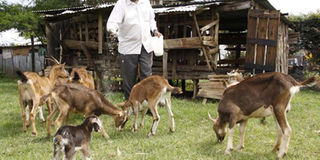A-Z of raising quality dairy goat kids, from birth to maturity

A dairy goat farmer feeds his goats. Weaning of goats kids can be done at six weeks with late weaning up to 12 weeks of age. FILE PHOTO | NATION MEDIA GROUP
What you need to know:
- Immediately after birth, the first thing to check for is if the newborn is breathing with ease or not. Remove all the mucus from the nose and around the mouth for good breathing.
- If colostrum is not available at all, may be due to mastitis on the doe, then whole milk is an alternative. If not left to suckle, colostrum can be nipple fed to the kid to ensure adequate consumption.
- Though goats are small ruminants, the kid’s digestive system is not fully developed at birth. As they grow, about two to three weeks of birth, introduce fibrous forages and other solid foods like grains, sweet potato vines, leaves of legume trees, grass, hay or concentrates.
- Under these conditions, the kids attain optimal growth rate, feed efficiency and stay healthy.
As any other young animal, dairy goat kids are the future of a farm. Therefore, management practices should aim at fostering a fast-growing, healthy herd and continuity of production.
The journey always begins at birth. At this time, the kid is new to the environment, therefore, the kidding surrounding should be clean and free of disease-causing germs.
Immediately after birth, the first thing to check for is if the newborn is breathing with ease or not. Remove all the mucus from the nose and around the mouth for good breathing.
Then treat the navel with iodine to prevent disease-causing organisms from reaching the navel cord. This also helps in rapid drying, and eventual breaking away of the cord from the navel.
Failure to use iodine may cause navel ill condition and death.
The next critical action to survival and future health of the kid is feeding on colostrum. Feed the newborn with colostrum as soon as possible, preferably within the first 24 hours of birth when they can absorb the essential antibodies.
This is the first ‘food’ for the young one that acts as a laxative in the digestive tract, provides an excellent source of nutrients and contains antibodies that protect the newborns from harmful bacteria and viruses, until their own immune system begins to function, normally between three to eight weeks.
It is high in nutrient value, including vitamins A, B, proteins and minerals. Kids that do not receive colostrum become less resistant to diarrhoea and other ailments later as they grow.
If colostrum is not available at all, may be due to mastitis on the doe, then whole milk is an alternative. If not left to suckle, colostrum can be nipple fed to the kid to ensure adequate consumption.
INTRODUCE FIBROUS FORAGES
After about two days of colostrum, feed the kid on pasteurised goat’s milk. Some farmers prefer to alternate this with milk replacers or feeds both at the same time at half rate a piece. This continues up to weaning.
Though goats are small ruminants, the kid’s digestive system is not fully developed at birth. As they grow, about two to three weeks of birth, introduce fibrous forages and other solid foods like grains, sweet potato vines, leaves of legume trees, grass, hay or concentrates.
These encourage rumen development together with the muscles of the rumen wall, which is important in digestion and mixing of rumen contents. The kid also starts chewing cud.
At this stage, most farmers prefer substituting fresh doe’s milk with milk replacers. Note that milk replacers of poor quality, especially with high starch levels will restrict growth rate of the kid. Fats in the milk replacer that are not properly homogenised also contribute to poor performance of the kids.
As part of feeding, remember to always provide clean water and mineral salts.
Weaning
At this stage, the kids may experience weaning shock often characterised by slowing of growth and sometimes loss of weight.
The degree of shock, however, relies on the age, weight and the feeding programme before weaning, thus, the need for close care and handling.
Weaning is defined by more reliance on solid feeds to supply most of the goat’s nutrients and achieved best gradually. Early weaning can be done at six weeks with late weaning up to 12 weeks of age.
Housing
Set a separate space for the kids within the goat housing. They should be housed in a barn that is clean, warm and has dry bedding.
The floor can be made from cheaply available material like timber and spaced to allow wastes and urine to pass through. Proper ventilation is also necessary to prevent respiratory problems.
Under these conditions, the kids attain optimal growth rate, feed efficiency and stay healthy.
The writer is based at Egerton University. For further information on raising dairy goat kids, visit www.dairycloud.co.ke to download an extension newsletter by the university.





